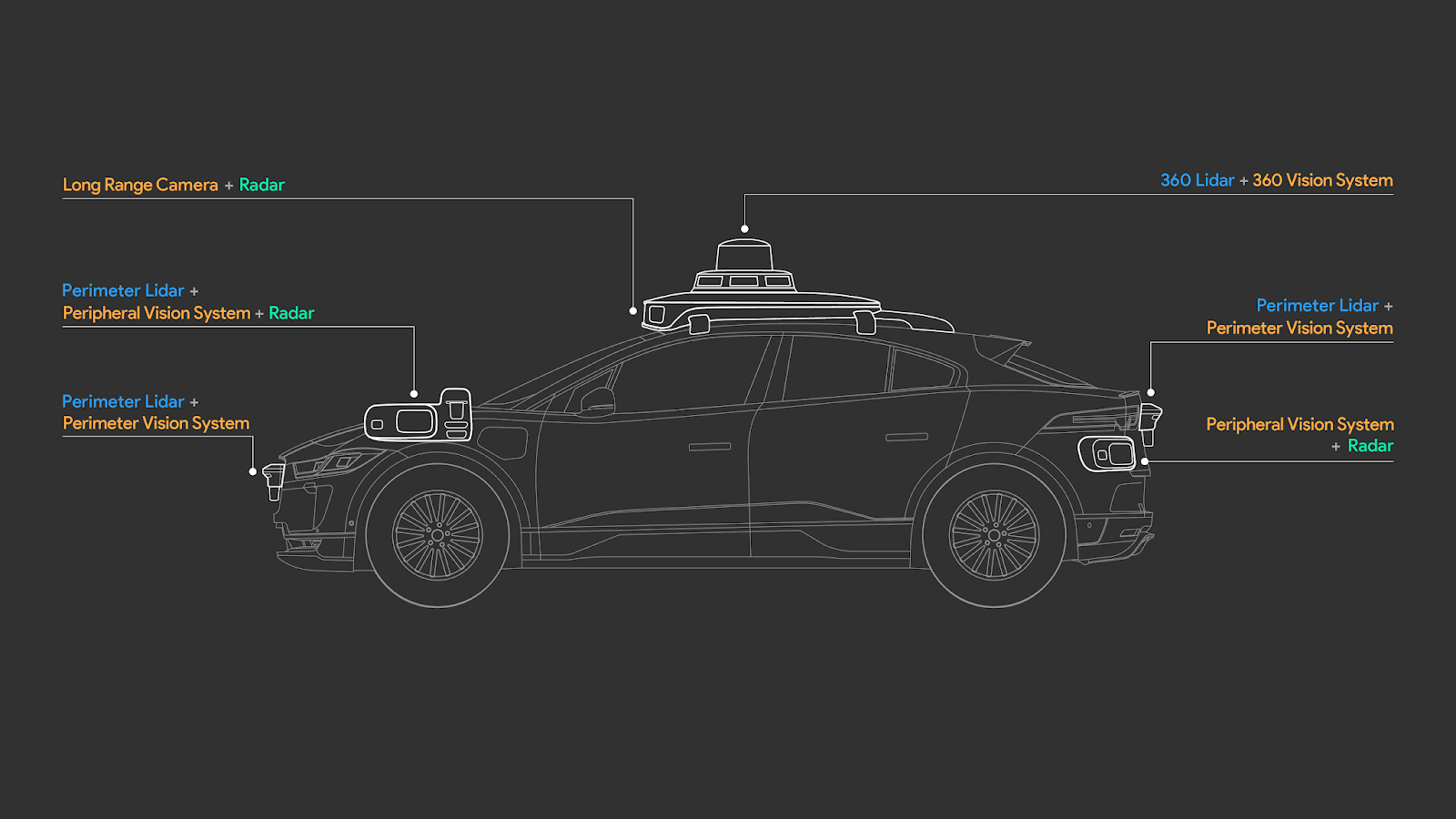I know you know the Waymo system well. They say their latest sensor suite (in the I-Pace) has a 300m range and I assume they have more than one.
With what you know, what would be your guess on the current system’s power consumption? (including the computing power necessary)
@Bladerskb knows Waymo better than I do. He can provide his own estimate.
But let me try to break it down as best that I can.
There is only 1 lidar that is 300 m, it's the big one at the top. That is a little over twice the range of the spinning lidar I quoted earlier with a power consumption of 60W. So let's say that Waymo's main lidar on top is 120W. The perimeter lidars are short range so probably around 100-150 m. Those are probably around 10W like I quoted earlier. There are 4 of those as you can see in the diagram, the 2 on the sides, and the front bumper and rear bumper ones. So let's say 40W. We see that there is a main long range forward facing radar at the top. My source suggests around 20 W. The perimeter radars are probably shorter range so maybe 10W. There are 4 of those. So that's 60W total. I think cameras are about 1W. Waymo has 29 cameras. So let's say 29W. The computer is probably 20 W, going by Mobileye plans to use 2 eyeQ5 chips of 20W total.

Waypoint - The official Waymo blog: Introducing the 5th-generation Waymo Driver: Informed by experience, designed for scale, engineered to tackle more environments
So my completely educated guess based on other, similar hardware, would be a total power consumption of the entire FSD hardware including the computer to be around 269W. Of course, we don't have Waymo's exact numbers. Waymo custom builds their hardware in-house. It is possible that Waymo has achieved a lower power consumption.
I would also point out that Waymo has ordered 20,000 Waymo I-Pace robotaxis. Surely, they would not have ordered that many if the power consumption was too high and the range was too low. They must be confident that the cars will work for their ride-hailing needs.
60W for a single sensor with half the range Waymo states is already is not very promising. Imagine, two of these sensors could consume more than Tesla’s complete FSD system. That is a huge engineering challenge. The 5th generation hardware looks terrible right now, like a large add-on and we have not seen this addressed on any production car as of yet. There is still a lot of work to do. I still don’t understand what Waymo’s plans are to integrate this in a car with power consumption matching Tesla’s, aerodynamics matching Tesla’s and cost matching Tesla’s. This to me seems like a massive showstopper as their hardware solution is still many years away of making sense for a mass volume taxi.
I know it is natural to want to compare to Tesla since we are Tesla owners on a Tesla forum. But why does the Waymo FSD hardware have to match Tesla in cost, aerodynamics and power? Waymo just needs a city robotaxi. Waymo just needs FSD hardware that can do driverless FSD, at an acceptable cost and range for a city robotaxi. Waymo is not trying to sell cars at a profit like Tesla is. Waymo is not trying to outsell Tesla. As long as Waymo has a city robotaxi that works for their needs who cares if it uses more power or the sensors looks like an add-on?
Personally, I think this pic of the Waymo Jaguar I-Pace looks pretty well integrated into the car. Everything, except perhaps the roof pod, is very well integrated into the car. It definitely looks more integrated than the Chrysler Pacficas. And Waymo has made it more aerodynamic than the hardware on the Chrysler Pacifica's. Sure, the roof pod still looks like an add-on but who cares if you are ride-hailing? Honestly, this pic looks fine to me.
I would also remind you that Tesla's hardware has not proven it can do true driverless FSD yet. If it cannot do that, cost, power and aerodynamics are a moot point. You can have the cheapest, lowest power, most aerodynamic car, but if the hardware cannot do true FSD, then you don't have a FSD car.
Of course, it might not matter for Tesla. Some would argue that cheap, low power hardware that delivers advanced L2 on millions of cars everywhere is still more valuable than more expensive, higher power hardware that delivers true driverless on a limited number of city robotaxis. It depends on what your goals are.




